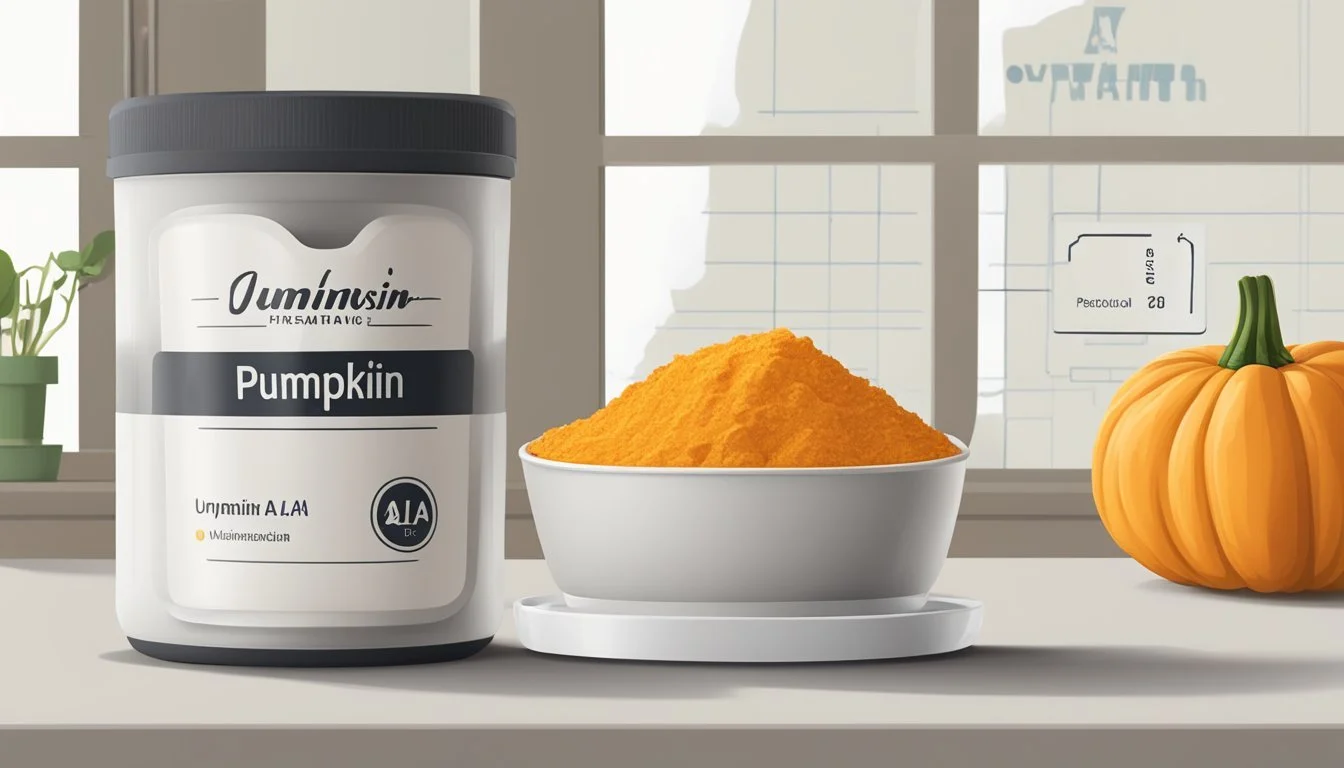How Many Cups of Pumpkin to Meet Your Vitamin A Needs
Pumpkin stands out in the realm of nutrition for its high vitamin A content, offering substantial nutritional value within a low-calorie profile. It's a versatile food that provides a notable amount of vitamins and minerals. The brightly colored flesh of pumpkins owes its hue to the presence of beta-carotene, a precursor to vitamin A, which is essential for eye health, immune function, and skin integrity.
One cup of cooked pumpkin can provide a significant percentage of the recommended daily intake of vitamin A. Given the importance of this vitamin to vital bodily functions, including a serving of pumpkin in your diet can contribute to fulfilling your nutritional requirements. The actual amount of pumpkin that one should consume to meet their vitamin A needs varies based on several factors, including age, sex, and overall diet.
When considering the addition of pumpkin to the diet specifically for vitamin A, it's essential to understand that balance is key. While it's a rich source of this nutrient, a varied diet that includes an array of vitamin-rich foods ensures a holistic approach to health. Monitoring the intake of vitamin A is also crucial since both deficiency and excess can lead to health issues.
Nutritional Profile of Pumpkin
Pumpkin is recognized for its nutrient density, offering a broad spectrum of vitamins, minerals, and macronutrients while maintaining a low calorie count. This makes it an excellent food choice for obtaining essential nutrients, including a significant amount of vitamin A.
Vitamin Content
Vitamin A: One cup of cooked pumpkin contains over 200% of the recommended daily intake of vitamin A, essential for eye health and immune function.
Vitamin C: Pumpkin provides a good source of vitamin C, which is vital for skin health, immune defense, and collagen production.
Beta-carotene: This precursor of vitamin A gives pumpkin its vivid orange hue and acts as a powerful antioxidant.
Carotenoids: Besides beta-carotene, pumpkin is rich in other carotenoids like lutein and zeaxanthin, which are linked to eye health.
Vitamin E: Present in smaller amounts, this fat-soluble antioxidant helps protect the body against oxidative stress.
Minerals and Trace Elements
Potassium: With 394mg per one-cup serving, pumpkin is a great choice for maintaining heart health and electrolyte balance.
Calcium: Essential for bone health, a one-cup serving of pumpkin contains about 24.4mg of calcium.
Magnesium: This mineral, involved in over 300 biochemical reactions in the body, is also found in pumpkin.
Iron: Pumpkin seeds especially are known for their iron content, which is critical for blood health.
Macronutrients
Calories: A one-cup serving of boiled pumpkin provides approximately 49 calories, making it a low-calorie food option.
Protein: Pumpkin contains about 1.8g of protein per one-cup serving, contributing to muscle maintenance and repair.
Carbohydrates: With 12g of carbohydrates and natural sugars, pumpkin can be an energy source for the body.
Fiber: A one-cup serving contains about 0.6g of fiber, which aids in digestion and satiety.
Fat: Naturally low in fat, with only 0.2g per serving, pumpkin can easily fit into a low-fat diet.
Health Benefits of Pumpkin
Pumpkin is a nutrient-dense food that contributes significantly to overall health, particularly due to its high Vitamin A content. It supports various bodily systems and can help prevent chronic health conditions.
Heart and Circulatory Health
Pumpkin is a valuable food for maintaining heart and circulatory health. Its high fiber content can assist in lowering cholesterol levels, and it is rich in potassium, which is known to help manage blood pressure. Moreover, pumpkin contains Vitamin C and beta-carotene, which have been linked to reducing the risk of heart disease.
Vision and Eye Health
The high levels of Vitamin A in pumpkin are crucial for eye health, specifically in preventing macular degeneration, a leading cause of vision loss. Beta-carotene, which the body converts to Vitamin A, also plays a role in protecting the eyes from age-related vision decline.
Cancer Prevention and Antioxidant Effects
Pumpkin is abundant in antioxidants that help neutralize harmful free radicals, potentially reducing cancer risk. The beta-carotene found in pumpkin is particularly noted for its association with a decreased risk of certain types of cancer, including prostate and lung cancer.
Skin Health and Immunity
Pumpkin supports skin health due to its Vitamin A and C content, which aid in collagen production, skin repair, and immune defense. Furthermore, pumpkin is a source of zinc, a mineral vital for maintaining healthy skin and a robust immune system.
Regulation of Blood Sugar and Weight Management
Including pumpkin in one's diet may contribute to regulation of blood sugar levels, which is beneficial for weight management. Its low calorie but high nutrient profile can also promote a feeling of fullness, potentially preventing overeating and aiding in weight control.
Culinary Uses of Pumpkin
Pumpkin is not only rich in vitamin A but also versatile in the kitchen, lending itself to a variety of both sweet and savory preparations. Its seeds offer additional nutritional benefits and can be roasted to create a heart-healthy snack.
Savory Pumpkin Dishes
Pumpkin, often considered a vegetable, is a type of squash that features prominently in savory dishes due to its rich, earthy flavors. (What wine goes well with earthy flavors?) When used in soups, it can be blended to a creamy texture and paired with ingredients like cinnamon or honey for a hint of sweetness. The high antioxidant content of the pumpkin flesh benefits the heart and can be incorporated into nutritious Thanksgiving side dishes. For a stronger flavor, the oil from pumpkin seeds is used to dress salads or drizzle over finished dishes.
Soup: Pumpkin puree, chicken or vegetable broth, cinnamon, nut outmeg, dash of honey
Roasted Pumpkin Seeds: Tossed in olive oil, sea salt, and optionally spiced with cayenne
Pumpkin in Sweet Treats
Pumpkin is a staple in sweet treats, especially known for its role in the iconic pumpkin pie. Baked goods like muffins and pancakes benefit from the addition of canned pumpkin, which adds moisture and flavor with minimal added sodium. The addition of pumpkin spice, a blend of cinnamon, nutmeg, and cloves, highlights the natural sweetness of pumpkin in desserts.
Pumpkin Pie: Pure canned pumpkin, evaporated milk, eggs, pumpkin spice, and sugar
Pumpkin Muffins: Canned pumpkin mixed with flour, sugar, eggs, cinnamon, and baking powder
Healthy Pumpkin Substitutes
Pumpkin can serve as a nutritious substitute for ingredients in various recipes. Due to its smooth texture, it can replace some of the fat components in recipes for a healthier alternative. For example, it can be mixed with yogurt to create a creamy base for a smoothie or used instead of oil in cake batters.
Yogurt Smoothie: Blend pumpkin puree, Greek yogurt, banana, honey, and cinnamon
Baked Goods Substitute: Use pumpkin puree to replace oil or butter in recipes for a lower fat content
Pumpkin Varieties and Selection
Selecting the right pumpkin variety is essential for both nutritional benefits and culinary use. Key characteristics and common types will determine the suitability for cooking and vitamin intake.
Optimal Characteristics
When choosing pumpkins for their vitamin A content, individuals should look for orange, edible varieties, as the orange color indicates a high level of beta-carotene, which the body converts into vitamin A. The pumpkin should have a smooth texture and a sturdy stem, which often signifies freshness and overall quality. The flesh should be firm, suggesting that the pumpkin is not overly ripe or beginning to decay.
Common Types for Consumption
Sugar Pumpkin: This variety is small, round, and ideal for cooking, known for its sweet flavor and smooth texture that is perfect for pies and soups.
Pie Pumpkin: Specifically bred for baking, these pumpkins are also round and relatively small, with dense and sweet flesh.
Winter Squash: Although not a true pumpkin, varieties such as butternut squash can be used interchangeably in recipes. Butternut squash is rich in nutrients, and its orange flesh is an excellent source of vitamins.
For those looking to enhance their vitamin A intake through diet, incorporating the right pumpkin variety into meals can be a tasty and effective way to achieve this goal.
Cultural Significance and Celebratory Use
Pumpkins, with their vibrant orange hue, stand as iconic symbols in North American festivities, especially during Halloween and Thanksgiving.
Halloween and Symbolism
Each year, as October 31st approaches, pumpkins become synonymous with Halloween. They are traditionally carved into jack-o'-lanterns, with flickering lights placed inside to create an eerie effect meant to ward off evil spirits. The practice originated from an Irish myth about a man named Stingy Jack and has since turned into a beloved Halloween tradition in North America.
Thanksgiving and Seasonal Recipes
Pumpkins also play a starring role in Thanksgiving celebrations. Prized for their sweet and earthy flavor, they are often baked into pies—a staple dessert at many Thanksgiving dinners. The significance of pumpkin pies during this holiday ties back to the harvest theme and the emphasis on abundance. Not only does the pumpkin's rich color and taste complement the fall season, but its nutritional value, rich in Vitamin A, makes it a healthy ingredient in various seasonal recipes.
Pumpkin Preparation and Storage
Proper preparation and storage of pumpkin are crucial to maintain its nutrient density and texture. These techniques ensure that the beneficial vitamins and minerals such as phosphorus, manganese, iron, and folate are preserved.
Cooking Techniques
When cooking fresh pumpkin, one can utilize various methods to enhance flavor and retain nutrients:
Roasting: Slice the pumpkin into consistent pieces, remove seeds, and roast at 375°F for about 30 minutes or until tender. This method caramelizes the natural sugars, providing a rich flavor.
Boiling: Cut the pumpkin into chunks and boil until soft. Boiled pumpkin can be pureed for recipes or mashed as a side dish; however, some water-soluble nutrients can be lost in the process.
Steaming: For a nutrient-retentive method, steam pumpkin pieces until tender, preserving most of the vitamins and maintaining the firm texture.
Microwaving: A quick method for cooking pumpkin involves cutting it into halves or slices, placing it in a microwave-safe bowl with a bit of water, and cooking it on high until soft.
One should avoid overcooking to prevent nutrient loss, especially when aiming to maximize the intake of vitamins and minerals.
Preservation Methods
To retain the pumpkins’ nutritional value for later use, these preservation methods are effective:
Freezing: Cooked pumpkin can be frozen in air-tight containers or freezer bags. Prior to freezing, ensure the pumpkin has cooled completely to prevent ice crystal formation, which can alter the texture.
Canning: Pumpkin can be canned in cubes but not pureed, as the density can affect the safety of home canning—refer to safe canning practices before attempting.
Drying: Pumpkin seeds can be dried and stored for later use. They are a good source of iron, manganese, phosphorus, and folate. Spread seeds on a baking sheet, roast at a low temperature until dry, and store in an airtight container.
Utilizing these preparation and preservation methods will help one make the most out of pumpkin’s seasonality, ensuring a supply of this nutrient-dense food is available year-round.
Pumpkin and Dietary Considerations
Pumpkin is a highly nutritious fruit that serves as a rich source of vitamin A and provides a variety of other health benefits. Low in calories and nutrient-dense, it makes an ideal choice for those looking to maintain a balanced diet while ensuring adequate intake of essential vitamins and minerals.
Nutritional Profile of Pumpkin:
Calories: Quite low, making it a weight-friendly food.
Vitamins: Particularly high in vitamin A, crucial for vision and immunity.
Minerals: Contains iron, potassium, and magnesium – all important for bodily functions.
Pumpkin’s vitamin and mineral content make it beneficial for heart health and may contribute to better immunity. The iron and magnesium content aid in multiple essential functions, while potassium supports heart health.
In terms of dietary fiber, pumpkin is a commendable source, which can aid in digestion and provide benefits for diabetes management. Moreover, it contains zinc, which plays a role in immune function, and copper and manganese, both necessary for overall health. Another nutrient found in pumpkins is folate, important for DNA synthesis and repair.
Being versatile, pumpkin fits well in both sweet and savory recipes, expanding its use across various cuisines. Whether utilized in its pure form or as seeds, pumpkin's benefits make it a valuable addition to meals.
Incorporating pumpkin into one’s diet can assist in meeting the recommended daily intake of several nutrients, including vitamin A, without adding excessive calories. This balance makes pumpkin a smart choice for those seeking a nutrient-dense diet that supports overall well-being.
Research and Future of Pumpkin in Nutrition
Pumpkin, recognized as a nutrient-dense food, presents an array of health benefits owing to its high antioxidant content, particularly vitamin A. Carotenoids, like beta-carotene, which the body converts to vitamin A, contribute to pumpkin's status as a formidable ally against eye health conditions, including age-related macular degeneration. The rich presence of antioxidants is also associated with risk reduction for diseases like heart disease and cancer.
Research suggests that the bioactive components in pumpkin can support the immune system. The anti-inflammatory properties of substances in pumpkin flesh and seeds might play a role in controlling infections and chronic diseases. Ongoing studies are exploring the role of pumpkin in regulating blood pressure, a critical component in the prevention of heart disease, by virtue of potassium and vitamins.
The future of pumpkin in nutrition science looks promising as it continues to be a focus for its therapeutic applications, including its potential role in preventing and managing diabetes as well as ameliorating arthritis symptoms due to its anti-inflammatory effects.
With the advent of nutrigenomics, there is growing interest in how pumpkin's rich nutrient profile might interact with individual genetic makeup to promote health. As the scientific community delves deeper into the synergistic effects of pumpkin's nutrients—such as carbs, fibers, and delta-7-sterols—as well as its potential mood-stabilizing effects through compounds like lithium, pumpkin could become a tailored functional food in dietary plans.
Here is a brief overview of pumpkin’s nutritional components per cup:
Vitamins: High in vitamin A
Antioxidants: Contains carotenoids
Minerals: Potassium for heart health
Immune Support: Nutrients that may enhance immune function
This versatile fruit is slated to surface more frequently in nutritional guidelines and prescriptions, as its full potential is tapped in the realm of health and dietary recommendations.










